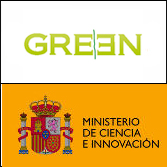
End: 31/12/2014
Funding: National
Status: Completed
Advanced Signal and Information Processing (ASIP)
Acronym: GRE3N
Code: TEC2011-29006-C03-01
Conventional designs of wireless communications systems have taken in many cases the traditional approach of dividing the functionalities to be implemented among separate layers or levels, namely, component, physical, link, medium access, and system levels. Usually, the design is performed separately at each level without exploiting completely the interactions among them. In addition to this, many times the design is driven by the objective of guaranteeing a certain prefixed quality of service (QoS) and only considers transmission power as a limiting factor.
Currently, there exists a recognized general trend for providing solutions in all fields, also in the information and communications technologies, which are energy efficient. In the concrete case of wireless mobile networks, this objective of achieving global energy efficiency has two main consequences. The first one is that full cross-layer approaches have to be exploited where all the levels and layers of the communications system are designed jointly (i.e., exploiting their interactions) under the objective of providing such energy efficiency. Only by following this philosophy, full efficiency will be a fact. Second, global energy efficiency cannot be achieved if only transmission power is considered. In current wireless networks, radiated transmission power (both at the mobile terminals (MTs) and the base stations (BSs)) is becoming less important and other sinks of energy consumption are taking levels in the same order of magnitude, or even higher. An example are femtocell networks, where the distances are very low, and so is the transmission power. In such cases, the power consumption of the base-band circuits implementing decoding algorithms can be even higher than such transmission power. In fact, current research activities are giving as a result the proposal of increasingly complex algorithms, specially for multi-antenna systems, which will require even higher levels of energy consumption at the base-band stages. In addition to that, there are other sinks of energy consumption (RF chain, cooling of the BSs, etc.) that should be taken into account.
Another aspect related to energy efficiency in mobile communications is the fact that the batteries of the MTs are limited in capacity. In this sense, an enhanced deployment of the network should be based on adaptive strategies that take into account not only the current channel state, as classical solutions usually do, but also the current status of the batteries. Thanks to this, the individual lifetime of the MTs could be enlarged, which, in some cases like relay-based networks, also implies an enhancement of the global lifetime of the network itself. In other words, energy efficiency and global lifetime are also inherently related. Finally, and also related with battery capacities, energy harvesting strategies are becoming a method to extract energy from the environment and charge the battery in a physically unplugged mode. Although current values for the energy harvesting are low, it is expected that they will increase in the near future and, therefore, they should be taken into account in the designs. Finally, from a system level point of view,
coordination and cooperation between BSs is also a key feature for the reduction of the global energy consumption through the control of interferences, bearing in mind that a large energy is consumed at BSs.
Taking into account all the previous issues, this project GRE3N (General Radio concepts for ENergy cogNizant mobile communicatioNs) aims at proposing a new approach and view of global energy-cognizant wireless communications systems where the different levels of the network comprising the component (hardware) level, the physical layer, the data link layer, the medium access control, and the system levels are designed in an energy efficient way and exploiting the interactions among such levels. This will be accomplished by considering the different sinks of energy consumption (beyond the limited and classical way of considering only the transmission power itself), the fact that the capacity of the batteries of the MTs is limited, methods for energy harvesting, and cooperation/coordination among BSs and saving modes.
This coordinated project will be composed of three subprojects:
- GRE3N-PHY (PHYsical layer aspects, developed by Centre Tecnològic de Telecomunicacions de Catalunya – CTTC). TEC2011-29006-C03-01
- GRE3N-LINK-MAC (LINK and MAC layer aspects, developed by Universitat Politècnica de Catalunya – UPC). TEC2011-29006-C03-02
- GRE3N-SYST (SYSTem level aspects, developed by Universidad Carlos III de Madrid – UC3M). TEC2011-29006-C03-03
Each partner will focus on a more specific layer or level of the communications system, although the three partners will cooperate and interact to achieve the desired global energy efficiency. CTTC will focus on physical layer aspects and will implement some techniques developed in this project in a real-time FPGA-based multi-antenna testbed. UPC will design and evaluate energy efficient adaptive link and medium access strategies. Finally, UC3M will focus on the problem from the system level point of view working on the control of interference from an energy efficiency point of view and exploiting cooperation and coordination between several BSs.
Note: Even if the coordinated project ended in December 2014, the subprojects GRE3N-LINK-MAC and GRE3N-SYST requested an extension of the project duration until September 2015 that was approved by the funding institution.
Coordinator
